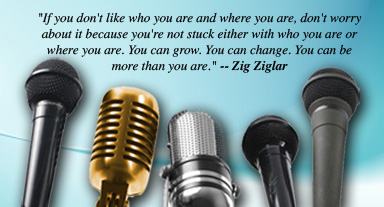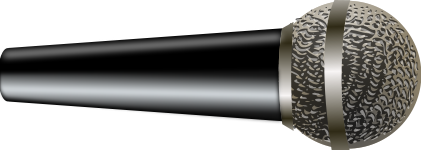Here’s a topic that can be of benefit to both event planners and emerging professional speakers themselves.
As an event planner it may be your responsibility to introduce the speaker on stage at your event. We discussed the ins and outs of crafting a speaker introduction and presenting it on Friday, but what about the technical aspects? Do you know how to use a microphone?
Microphone. Photo by Open Clip Art Library via Wikimedia Commons.There are a few types of microphones out there and each one has its own unique characteristics, but the two most common types are handheld microphones and lavalier microphones. Here’s what you should know about using them.
Handheld microphones
We all know what handheld microphones look like. They usually have a thick, sturdy black handle and are topped with a round black or silver almost-mesh-like ball that you speak into. There are newer, sleeker variations of handheld microphones out there, but this standard microphone is still most common. If your event is using a handheld microphone on stage, it will also generally come with a microphone stand.
Start by familiarizing yourself with the microphone and stand. Learn how to turn the microphone on and off and practise taking the mic in and out of its stand. Also learn how to adjust the stand to various heights and angles.
Raise the stand so that the microphone is at the same level as your mouth. And adjust the angle of the mic so it is pointed toward your mouth. Do this by holding onto the handle or neck of the microphone. Remember: Do not touch the ball of the mic while adjusting it, if you do and the mic is turned on you’re likely to create some unpleasant feedback.
The general rule is to position your face about eight to 10 inches in front of the microphone. Be careful not to get much closer than that. If you speak too close to the mic it may distort your voice and create strange hissing or popping sounds – or worse, it’ll produce high-pitched screeching and feedback. Try to remember that microphones are designed to capture and magnify the sounds that radiate toward them and across them and through them, they are not designed to capture sounds shouted directly into them.
When speaking into a microphone that is on a stand, be sure to stand straight and tall. The better your posture, the better and clearer your voice will flow from your diaphragm. If you have to bend your neck to speak into the mic, it is not positioned properly. Readjust it until you’re standing comfortably and you feel right. When talking into a microphone, talk at your normal speaking volume. Do not shout – it’s the mic’s job to amplify your voice, not yours. Feel free to move your body around while you’re speaking, just always ensure that your mouth is pointed toward the ball of the microphone and that it remains the same eight to 10 inch distance away from it.
If you opt to remove the microphone from its stand and hold it while you speak, there are a couple of key things to remember. Hold the microphone at chest level and be sure to keep the ball of the mic below your mouth and at an angle pointing toward your nose. And if the microphone has a cord attached to it, do be careful manoeuvring around the stage. You should be aware of where the cord is at all times to avoid tripping over it.
Finally, always do a sound check before your event. If your venue has a sound technician, make use of him. If not, familiarize yourself with the sound system and have somebody help you by moving around the room and checking the sound in various areas as you speak.
Lavalier microphones
Lavalier microphones are small hands-free microphones that get clipped onto your shirt front. Lavalier mics allow you more freedom and a greater range of movement. Some are wireless, while others have a small wire that runs from the mic to a small battery pack that gets clipped to the back of your waist.
Again, familiarize yourself with the on and off controls of the microphone. This is especially important with a lavalier mic: Due to their size and ease of use, it’s possible to forget you’re even wearing one. So make sure to turn your lavalier mic off as soon as you leave the stage – otherwise who knows what you’ll end up broadcasting to the audience.
The placement of a lavalier microphone is incredibly important. You’ll want to clip the mic about eight to 10 inches below your chin, and the closer to the centre of your body the better. As a result, if you know you’ll be using a lavalier mic, you need to dress appropriately. The mic can be clipped to a shirt collar if need be and a men’s tie works great. However, the best idea may be to wear a button-up shirt as you can always clip a lavalier mic to the shirt’s front placket. If you’ll be using a lavalier mic, make sure not to wear long dangly necklaces as they may bump the microphone and create unwanted noise or feedback. And if you have long hair, be sure to pull it back so it doesn’t cover the mic and muffle the sound.
Again, stand with good posture when using a lavalier microphone. The taller and more erect you stand, the more air there will be in your diaphragm and the clearer your voice will sound. And you’ll need to do a sound check with this type of microphone as well.
For more details on how best to use a microphone, check out the article “How Do You Use a Microphone Properly?” on Lisa B. Marshall’s Quick & Dirty Tips blog, The Public Speaker. Lisa is always an intelligent and informative source for good public speaking information.
Do you have any tips or funny stories about learning to use a microphone? Share them with us here or on the Inspiring Speakers Facebook page. Till next time!



